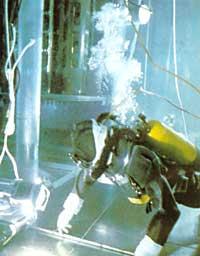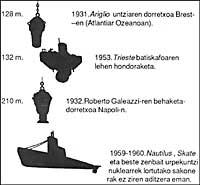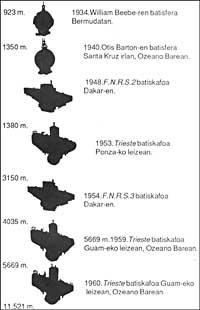History of Naval Industry XIV: Exploring the Seabed
Elhuyar Fundazioa

They tried to classify as much coastal plants and fish. To study the seabed, they only had a probe made on a long rope with a heavy weight of lead at the end.
The water itself had unsolved mysteries. Formerly they thought that the salt of sea water was due to land erosion. But this opinion was soon discarded when calculating the amount of salt contained in marine waters. In marine waters there are 5 x 10 16 tons of salt: Enough to cover the whole earth with a layer of 150 meters. Since then, the composition of marine waters and the chemical elements present in them have been analyzed in detail.
Important discoveries about life on the seabed have also been made. At first it was thought that, once from a certain depth, due to the high lower pressures and darkness, there was no life.
However, this opinion began to be questioned in the last century. In fact, in 2000 meters deep a telegraphic cable was lifted, with molluscs and shells. Since 1910, Prince Albert of Monaco captured a fish that lives 6000 meters deep. This fish, located in the Museum of Oceanography of Monaco, has a length of 50 centimeters, completely black and with a flexible visual antenna on the head.
The hole of the Philippines in the sea of the Islands has a depth of 11000 meters and from there a small white anemone was extracted.
As for plants, phytoplankton is only found in places where sunlight comes, but as it enters the darkness, chlorophyll action cells disappear. Instead there are others, and although not as abundant as on the surface, vegetation is important in the dark waters.
In the sea water, on the other hand, there is plankton, and we must not forget that it is food for any living being (from the big whale to the microscopic animals). So much research has been done on plankton.
Another phenomenon related to plankton is the mysterious background found by ultrasonic waves. This mysterious background echoes the waves, a background that lies at a depth of between 200 and 400 meters during the day, at dawn on the surface of the water and disappears at night. Some say that this phenomenon may be due to zooplankton migrations, but there is nothing clear.

However, in recent years the margins have been explored and the phenomena revealed in the darkness of the seabed. In 1932, for example, the technicians of the Italian ship Artiglio managed to extract the cargo from the British ship Egypt, which was 120 meters deep for ten years.
The depth of the 120 meters seemed great then, but when the Second World War ended, the batisfatos went down to greater distances. The performance of the engineer Otis Barton and the American naturalist Beebe stands out. A cast iron sphere was made. The dial had an inner diameter of 1.37 meters and a minimum wall thickness of 37.5 mm. It also had three lockers. In 1934 they reached 900 meters deep.
According to these two scientists, at a depth of between 600 and 700 meters, phosphorescent fish abound in the sea.
In 1948 Barton built a similar sphere, but giving more thickness to the wall. So it submerged until 1350 meters.
As a result of these balences, the well-known Swiss professor Auguste Piccard began to project his first beater. As a result, in collaboration with the Belgian National Foundation for Scientific Research, he was able to carry out the first batiscafo called F.N.R.S.2.
That first Batiscafo descended without people until 1380 meters deep in the sea of Dakar. In 1938 the baptism was broken and conquered by the French Army.
In 1954, the French army built the F.N.R.S.3 and in front of Dakar captain Houot and engineer Willm sank at the bottom of the sea up to 4050 meters. In those depths, the walls of the batisfato were reduced from 9 to 7 centimeters due to the enormous pressure.

However, in 1953, Mr. Auguste Piccard, with the help of his son Jacques, descended to 3700 meters in the Mediterranean Tyrant Sea. For this purpose the batiscafe "Trieste" was used.
In 1958 the ship "Trieste" was conquered by the Army of North America, and two years later Lieutenant Jacques Piccard and Donald Walsh descended to a depth of 11521 meters around the island of Guam, in the Pacific. This trip lasted 4 hours and 48 minutes. After half an hour at the bottom of the sea, they climbed another 3 hours and 17 minutes. The batiscafo suffered a pressure of 1187 kg/cm 2.
And finally, here are some of the milestones that have marked the conquest of the seabed:







